- Epic – It is something so large that it will almost certainly not fit into a sprint, is unclear in terms of client requirements, and should be split down into stories. Epics are often defined at the early stages of product road mapping and then broken into stories in the product backlog when additional information becomes available.
- User Story – A story is anything actionable that can be fit into a sprint. These are INVEST criteria-based story points and definitions. By the end of an iteration, stories should give a vertical slice of functionality to the client that is both valuable and complete. Typically, stories are developed throughout the product development process, particularly prior to iteration planning and throughout higher-level product road mapping.
- Task – They are the decomposed parts of a story that define how the story will be finished. If needed, tasks can be estimated by the hour. Tasks are typically defined by the individuals who execute the job, whereas stories and epics are typically developed by the customer. Because tasks are temporary, they are produced within the confines of an iteration.

Skill Yantra
Scrum Master Training Program Idea: “From Zero to Scrum Hero
connect@skillyantra.com
+91-90361 53201
FAQ
What is Scrum Framework:
Scrum is a framework for agile teams to collaborate. In the early 1990s, Ken Schwaber and Jeff Sutherland co-created the Scrum framework to aid firms grappling with complicated development projects. The team members can use it to deliver and maintain the complex product. It encourages the team to self-organize while working on the challenge and learn via practice. Scrum is a project that is carried out using the framework and delivers values to clients on a regular basis.
It is the most commonly utilized software by the development team. Its lessons and principles can be applied to any type of teamwork. Scrum framework’s popularity stems from its policies and experiences. Scrum is a set of tools, meetings, and roles that enable teams to structure themselves. It also supervises the team’s work.
Scrum Teams, as well as their related responsibilities, events, artifacts, and rules, make up the Scrum framework. Each component of the framework serves a distinct purpose and is critical to the success and adoption of Scrum. Scrum’s rules link events, roles, and objects together, regulating their relationships and interactions. In the following section, we will see what are the most commonly asked Scrum Master Interview Questions and Answers for Freshers and Experienced candidates.
What are the different roles in Scrum?
Following are the different roles in Scrum:-

- Product Owner: The product owner is in charge of enhancing ROI by determining product features, prioritizing these items into a list, determining what should be prioritized for the next sprint, and much more. These are re-prioritized and modified on a regular basis.
- Scrum Master: This person assists the team in learning how to use Scrum to maximize business value. The scrum master removes roadblocks, keeps the team focused, and helps the team embrace agile methods.
- Scrum Team: A Scrum Team is a group of people who work together to guarantee that the stakeholders’ needs are met.
What do you mean by Agile?
Agile is an iterative project management and software development methodology that enables teams to deliver value to clients faster and with fewer difficulties. An agile team provides work in small, consumable pieces rather than putting all on a “big bang” release. Requirements, strategies, and outcomes are all evaluated on a regular basis, giving teams a natural method for adapting to change.
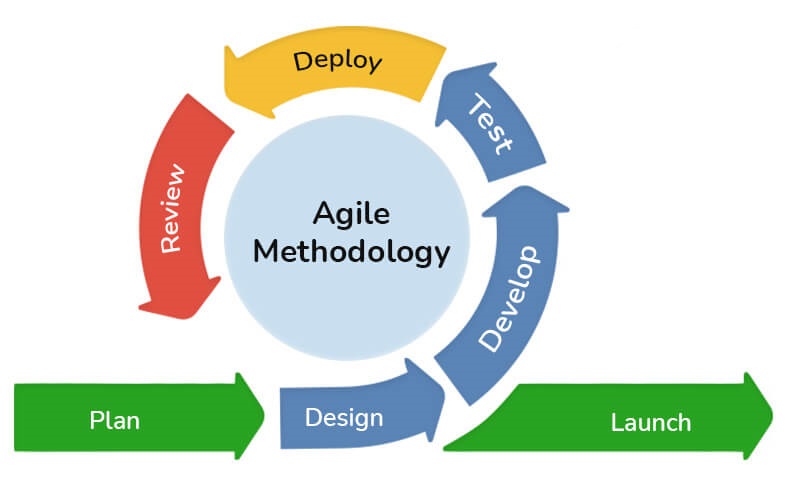
What do you mean by Sprint in Scrum?
A Sprint is at the heart of Scrum. It is a two-week or one-month period in which a potentially releasable product increment is generated. Following the conclusion of the preceding Sprint, a new Sprint begins. It breaks down large, difficult undertakings into manageable chunks. It helps teams provide high-quality work faster and more frequently, making projects easier to manage. Sprints provide them with more flexibility in adapting to changes.
Sprint planning, daily scrums, development work, Sprint review, and sprint retrospective are all part of a sprint.
- The work to be done in the Sprint is planned collectively by the Scrum Team during Sprint planning.
- The Daily Scrum Meeting is a 15-minute timed event in which the Scrum Team synchronizes efforts and creates a strategy for the following day.
- At the end of each Sprint, a Sprint Review is held to review the Increment and, if necessary, make modifications to the Product Backlog.
- After the Sprint Review and before the following Sprint Planning, there is a Sprint Retrospective. The Scrum Team will inspect itself and prepare a plan for changes to be implemented during the next Sprint during this meeting.
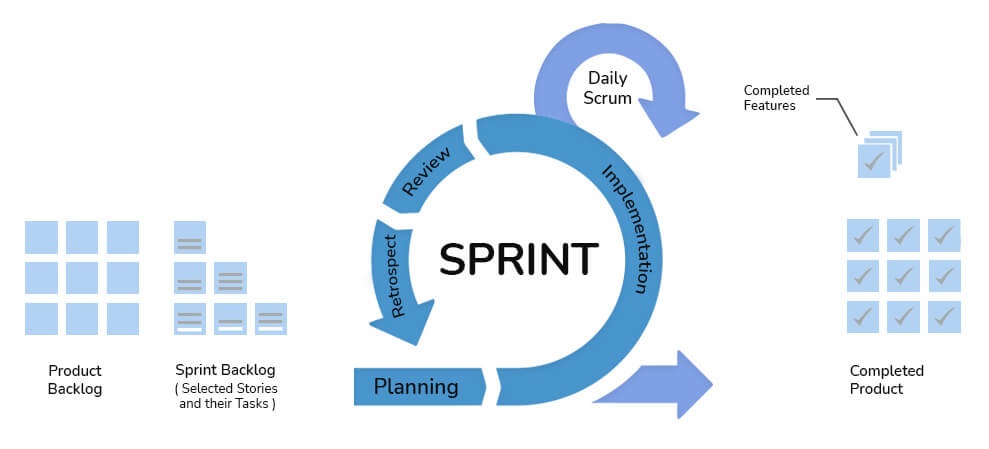
What are the five Scrum values?
Following are the five Scrum values:
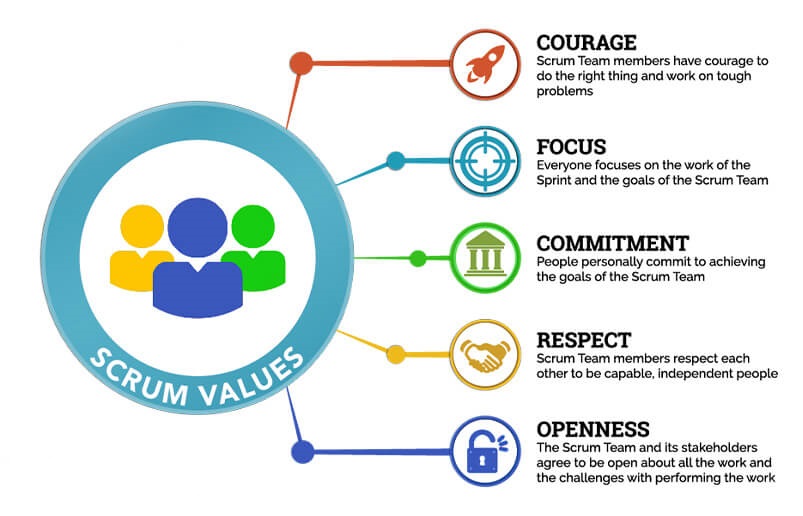
- Commitment: Scrum teams must be able to function as a team to accomplish a common goal. This entails putting faith in one another to complete their jobs and deliver to the best of their abilities. It will only occur if each team member is completely dedicated to the project and the team.
Scrum masters and team leaders can aid commitment by facilitating good sprint preparation and shielding teams from mid-sprint scope changes and undue product owner pressure. - Focus: Each member of the team must remain focused on the work at hand as well as how it affects the sprint goal in order to get the most out of each sprint.
Scrum masters might limit the number of tasks or priorities assigned to each team member throughout sprints to help them stay focused. Individuals can also stay focused on their assigned work by encouraging full team participation in daily Scrum meetings. - Openness: Each member of the team must be absolutely truthful about their personal progress in order for the Scrum team to accomplish the maximum progress in the quickest period possible. The daily Scrum meeting’s goal is to identify and solve problems. That won’t happen if team members aren’t honest about any problems or hurdles they’re facing. Team members must also be willing to collaborate with one another and see each other as vital contributors to the project’s success.
Being upfront with their teams is one of the finest methods for Scrum masters to foster openness. Giving honest feedback at daily Scrum meetings is not only crucial for making required adjustments, but it will also inspire team members to be honest and open in return. - Respect: Respect in a Scrum team implies understanding that no single individual or their contribution is more valuable than another. Respect also entails putting your faith in your coworkers to complete their jobs, listening to and considering their suggestions, and praising their achievements.
Scrum masters may assist their teams to develop regard for each other by exhibiting respect for the product owner, stakeholders, and team members. - Courage: Scrum teams must have the guts to be genuine, upfront, and honest about the project’s progress and any bottlenecks they encounter, both with themselves and with stakeholders. Members of the team must also have the bravery to seek assistance when needed, attempt new techniques or procedures that they are unfamiliar with, and respectfully disagree and engage in open debate.
Scrum masters, like respect, can first and foremost promote courage by displaying it. To avoid mid-sprint adjustments or scope creep, the Scrum Master must have the confidence to stand up to stakeholders and product owners.
What are the three pillars of Scrum?
Following are the three pillars of Scrum:
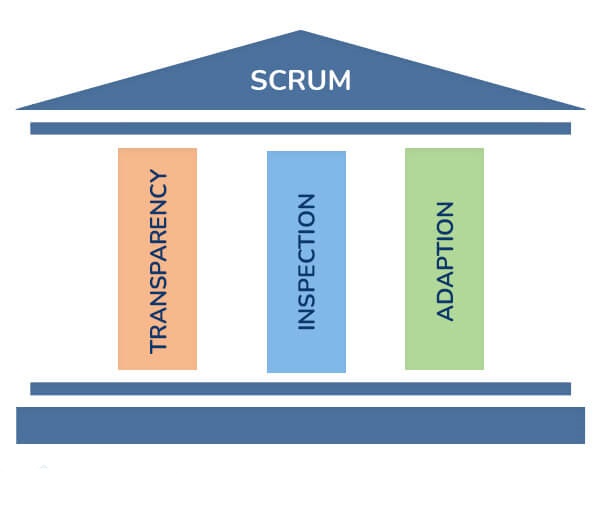
- Transparency: Those accountable for the outcome must be able to see important components of the process. Transparency necessitates that those elements be defined by a uniform standard so that viewers may comprehend what they are seeing. For example, all participants must speak the same language when referring to the process, and those performing the job and those inspecting the resulting increment must have the same concept of “done.”
- Inspection: To spot undesired deviations, Scrum users must examine Scrum artifacts and progress toward a Sprint Goal on a regular basis. Their inspections should not be so frequent that they become a hindrance to their work. Inspections are most effective when performed diligently at the point of work by skilled inspectors.
- Adaption: If an inspector concludes that one or more parts of a process deviate beyond acceptable boundaries, the method or the material being processed must be modified. To avoid future deviation, an adjustment must be performed as soon as feasible.
What do you mean by user stories in Scrum? What are the advantages of using them?
A user story is a casual, generic explanation of a software feature written from the end user’s perspective. Its goal is to communicate how a software feature will benefit the customer. Putting people first is a critical component of agile software development, and a user story does just that by putting end-users at the heart of the discussion. The development team and their efforts are described in these anecdotes using non-technical language. The team knows why they’re developing, what they’re building, and what value it adds after reading a user story.
Following are the advantages of using User Story:-
- The main advantage of User Story is the user-centric definition. This is because, in the end, the user will be the one who uses the product in the relevant user scenarios. It establishes a link between end-users and team members.
- The User Story’s syntax ensures that the objective, benefit, or value that the user wishes to attain is captured.
- The Scrum Team will benefit from the acceptance criteria because they are included in the user story.
- It is possible to make changes to a user story throughout the project’s execution. If the user story’s scope grows too large, it must be divided into smaller user stories. The acceptance criterion’s conditions can also be changed.
Who is responsible for writing User Story?
User stories can be written by anyone. Although it is the product owner’s job to ensure that an agile user story backlog exists, this does not imply that the product owner is the one who produces them.
During the early stages of product development, the team discusses needs and records them as user stories. As long as there is a product backlog, it will never be frozen. As a result, if someone thinks there’s a missing requirement or anything that could benefit the client, they can add it to the queue as a user story. There is no rule or guideline indicating that the stories must be written solely by the product owner. Because there is a set format, anyone creating the story should know exactly what it means and how to write it.
Explain user story structure with an example.
The User Story is outlined as follows:
As a <Type of User>,
I want <To Perform Some Task>,
So that <I can achieve some goal/benefit/value>.
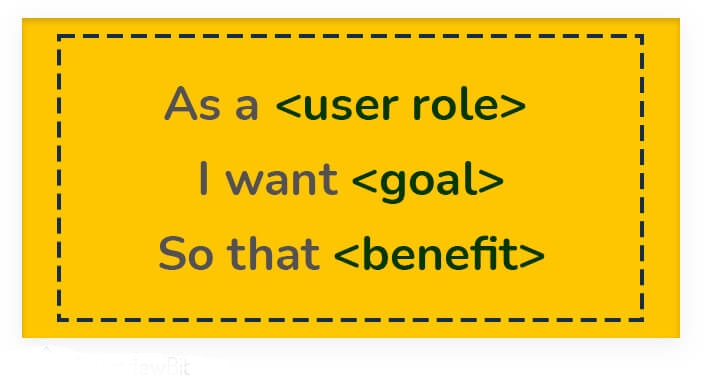
Example:
User Story in case of a person’s online purchase :
As a Customer,
I want to shop online from websites,
So that I do not need to visit the local market.
Is Scrum and Agile the same? If not so, differentiate between them.
No, Scrum and Agile are not the same. Following are the differences between them:
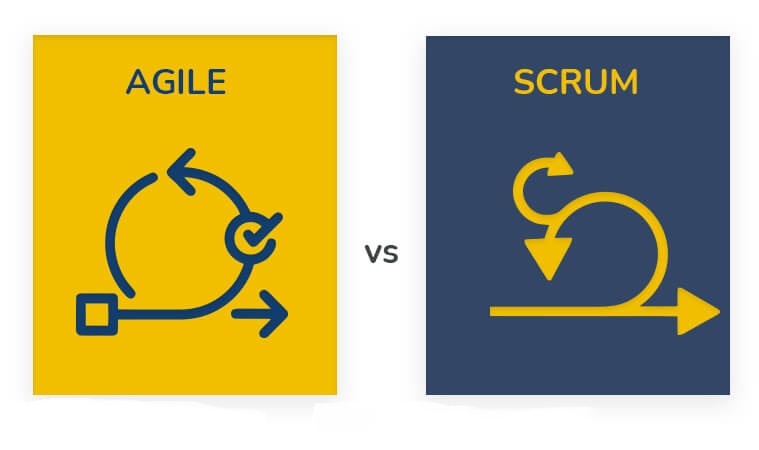
Agile
Agile is a development methodology that takes an incremental and iterative strategy.
Agile software development has long been seen to be best suited to situations with a small but highly skilled project development team.
It is a more rigid method when compared to Scrum. As a result, there isn’t a lot of room for regular modifications.
Agile entails cross-functional collaborations and face-to-face interactions between team members.
Agile development can necessitate a significant amount of up-front process and organizational change.
The design and implementation should be kept as simple as possible.
The most basic indicator of progress is working software.
Scrum
Scrum is one of the agile methodology’s implementations. In this scenario, the customer receives incremental builds every two to three weeks.
Scrum is best suited for projects with quickly changing requirements.
Scrum’s greatest benefit is its adaptability.
Collaboration is achieved in Scrum by holding daily stand-up meetings in which the scrum master, product owner, and team members each have a specific role to play.
When implementing the scrum process, there aren’t many adjustments that need to be made.
Innovative and experimental design and execution are possible.
Working software is not a basic criterion.
What are the roles of a Scrum Master?
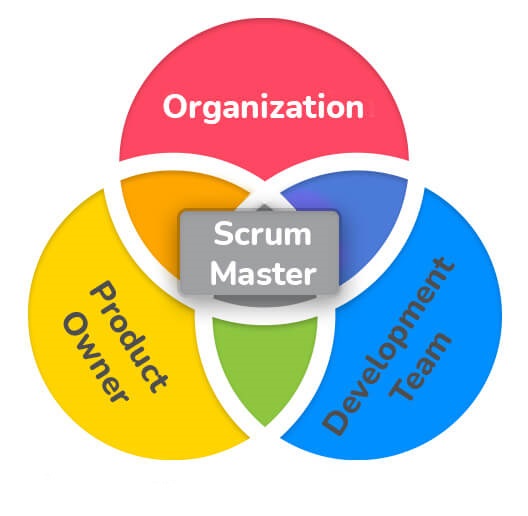
The Scrum Master provides support to the Scrum Team in a variety of ways, including:
- Mentoring members of the team in self-management and cross-functionality
- Assisting the Scrum Team in focusing on creating elevated Increments that meet the Definition of Done
- Removing roadblocks to the Scrum Team’s progress
- Ensuring that all Scrum events occur and are positive, productive, and kept within the timeframe.
The Product Owner benefits from the Scrum Master in a variety of ways, including:
- Assisting in the use of strategies for successful product goal definition and backlog management;
- Assisting the Scrum Team in comprehending the need of having clear and precise Product Backlog items;
- Assisting in the development of empirical product planning for a complicated environment
The Scrum Master helps the company in a variety of ways, including:
- Leading, mentoring, and training the organization’s Scrum adoption.
- Making plans and recommending Scrum implementations within the organization assisting employees and stakeholders in understanding and putting into practice an empirical approach to complex work.
- Removing barriers between stakeholders and Scrum Teams.
How can you assure that the user stories meet the requirements?
A good user story comprises a description as well as set acceptance criteria. It should be a piece that can be completed in a sprint and has the fewest dependencies possible. Within the sprint’s constraints, the team should be able to build and test while also delivering estimations. In a nutshell, the INVEST principle is followed by good user stories.
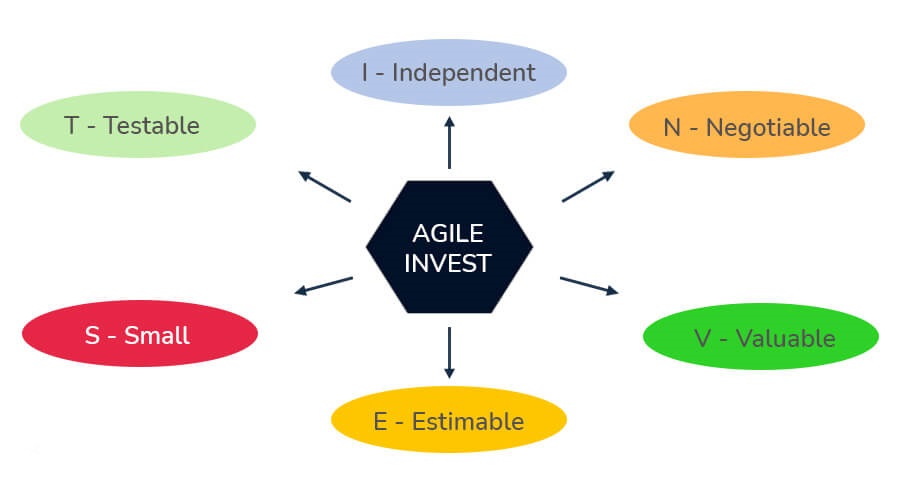
- I stands for Independent – The user story should be such that the team members are less reliant on others
- N stands for Negotiable – It should describe the functionality and is subject to agreement between the Team and the Product Owner.
- V stands for Valuable – It should add value to the customer’s experience.
- E stands for Estimable – It should be such that the time requirement can be approximately estimated.
- S stands for Small – It should be small enough so that the team can complete it in a sprint.
- T stands for Testable – It should have good acceptance criteria.
During backlog refinement or sprint preparation, the scrum master can assist the team in producing good user stories so that they can be picked up for the commitment.
Why are the user stories not estimated in man hours?
One of the most common approaches for evaluating teamwork is to estimate in man-hours. While man-hours are simple to comprehend, they have a number of significant drawbacks:
- Few activities, such as legacy work, are difficult to estimate precisely.
- If one team member delivers the estimate but the task is completed by another, the estimate is useless.
- The amount of time it takes to perform a task depends on the developer’s level of experience.
- Teams frequently overestimate the obstacles they may face and simply consider the best-case scenario.
The benefits of estimating user stories in points include the following: There is no association between the estimator’s skills and experience, and story points are independent of the story’s author. The team members can estimate more correctly since story points are a measurement of relative sizes, and the size of the story cannot be changed by external forces. As team behavior takes precedence over individual conduct, Story Points encourages collaboration. The team comes together when they use planning poker to estimate story points. As teams exchange, constructively criticize, argue, and have fun playing poker cards to arrive at an agreement on estimations, it serves as a team-building activity.
What do you mean by Artifacts in Scrum?
Scrum Artifacts contain critical information that the Scrum Team and stakeholders need to know in order to understand the product being developed, the activities that have been completed, and the activities that are planned for the project. The Scrum Process Framework defines the following artifacts:
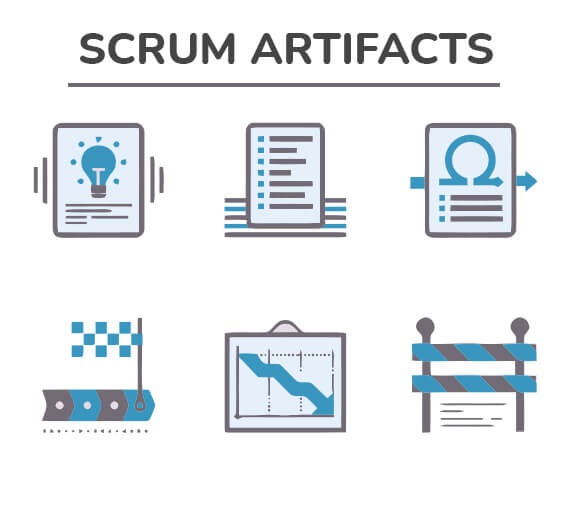
- Product Backlog: The Product Backlog is a list of all the features, functionalities, requirements, additions, and fixes that will be included in future releases of the product. Description, order, estimate, and value are all properties of Product Backlog items. The Product Owner is in charge of the Product Backlog’s content, as well as its availability and ordering.
- Sprint Backlog: The Sprint Backlog consists of the Product Backlog items chosen for the Sprint, as well as a strategy for delivering the product increment and achieving the Sprint Goal. It is the Team’s projection of what feature will be available in the next Increment, as well as the work required to turn that functionality into a working product Increment.
- Increment: The Increment is the total of all Product Backlog items accomplished throughout a Sprint plus all preceding Sprint increments. The new Increment must be a working product at the end of a Sprint, which means it must be in usable form. Regardless of whether the Product Owner decides to release it, it must be in functioning condition.
- Sprint Burn-Down Chart: The total work remaining in the Sprint Backlog can be totalled at any point throughout the Sprint. The team keeps track of the overall work remaining for each Daily Scrum to estimate the chances of meeting the Sprint Goal. The Team can control its progress by keeping track of the remaining work during the Sprint. The Sprint Burn-Down Chart is a method of tracking how much work the Scrum Team has done in a given sprint. This has been shown to be an effective method for tracking Sprint progress toward the Sprint Goal.
What are the five steps of Risk Management?
To manage risk, there are five essential measures to follow. They are as follows:
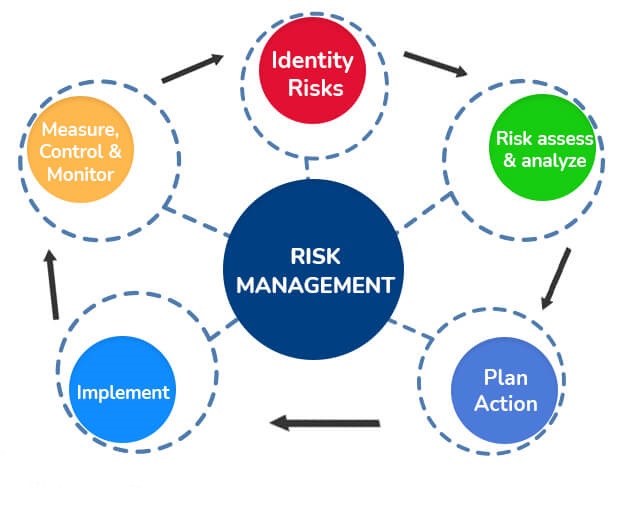
- Identification of Risk: The first step is to determine the risks that the company faces in its current operational environment. There are numerous forms of risks, including legal risks, environmental risks, market risks, regulatory risks, and so on. It’s critical to recognize as many of these risk variables as possible.
- Analysis of the Risk: It is necessary to examine a risk once it has been recognized. The risk’s scope must be assessed. It’s also crucial to comprehend the relationship between risk and other internal components. It is crucial to establish the severity and importance of the risk by looking at how many business operations it affects.
- Ranking the Risk: Risks must be prioritized and ranked. Based on the intensity of the risk, most risk management solutions have several risk categories. Risks that can result in serious loss are ranked the highest, while risks that may cause some inconvenience are rated the lowest.
- Treating the Risk: Every risk must be minimized or eliminated to the greatest extent practicable. This is accomplished by contacting specialists in the field to which the risk pertains. In a manual situation, this means calling each and every stakeholder and then scheduling up meetings for everyone to talk about and debate the concerns.
- Reviewing the Risk: The risk is then reviewed to ensure that the risk has been eliminated completely.
What do you mean by timeboxing in Scrum? When can a Sprint be cancelled and by whom?
Timeboxing refers to allocating a specific amount of time to a specific activity. A timebox is a time measurement unit. A timebox should be no more than 15 minutes long.
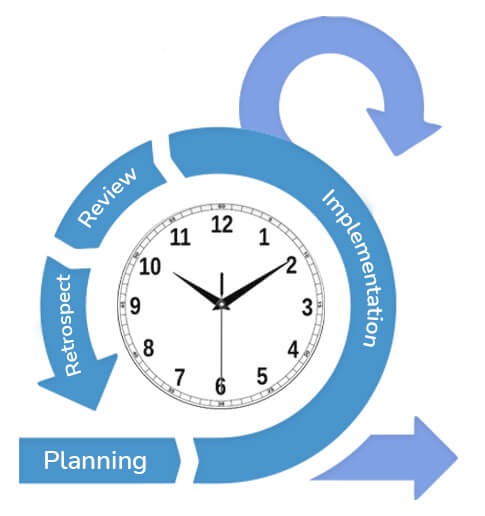
Before the Sprint timebox limit expires, a Sprint can be canceled. The sprint can only be canceled by the Product Owner.
How are Epic, User Story and Tasks different from one another in the context of Scrum?
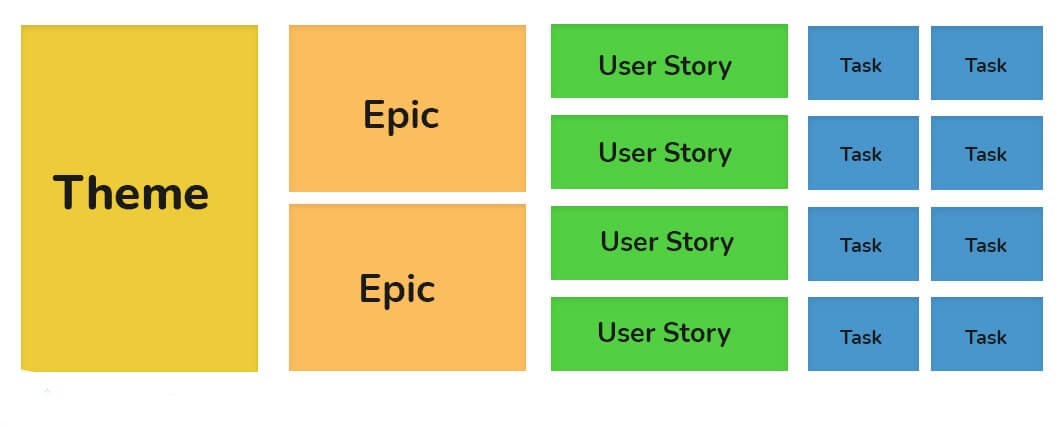
Who all can be the participants in the retrospective meeting?
The sprint retrospective is both a time to analyze and change the process and an opportunity to reflect on it. Attendance by the entire Scrum team is required. This includes the Scrum Master, the product owner, and all members of the development team (including everyone who is designing, building, and testing the product).
However, other teams may not want to include the product owner since it will obstruct their discussion. If there is a lack of trust between the product owner and the development team, or a lack of safety that prevents the product owner from speaking candidly, the product owner should not attend until the Scrum Master can help teach those engaged in building a safer, more trusting atmosphere. Anyone not on the immediate scrum team, especially team members’ managers, should not be invited to participate.
What do you mean by Sprint 0 and Spike?
The modest amount of effort put in to establish a rough skeleton of the product backlog is referred to as Sprint 0. It also contains information on calculating product release dates. Sprint 0 is necessary for the following tasks:
- Creating a skeleton for the project, as well as research spikes
- Maintaining a minimalist design
- Creating a few stories completely
- Being lightweight and having a low velocity
The spike is a collection of activities that use Extreme Programming for research, design, investigation, prototyping, and other purposes. It tries to mitigate the technical approach’s risks by assisting with the acquisition of knowledge in order to better comprehend requirements and increase reliability.
Differentiate between Product Backlog and Sprint Backlog.

Product Backlog
- It is a list of all the tasks that must be done before the final product may be created.
- The Product Owner is in charge of gathering, prioritizing, and refining the Product Backlog items.
- The Product Backlog is dedicated to the product’s overall goal.
- Depending on the customer’s vision, there may be opportunities to alter.
- It has nothing to do with the Sprint Backlog.
- It is the entire set or list of tasks that must be accomplished in order to fully develop the product.
- The Product Backlog exists and must be maintained until the entire product is developed.
Sprint Backlog
- It is a list of all the items collected from the Product Backlog that must be done in order for the Sprint to be completed. It also has a strategy for converting the selected items to an Increment.
- The Development Team is in charge of developing the Sprint Backlog and working on it in order to complete the Sprint on time.
- The Sprint Backlog solely pertains to the Sprint goal for that Sprint.
- The Sprint Goal will not change throughout the Sprint, but the Sprint Backlog may change depending on the Sprint.
- The Product Backlog is the sole determinant.
- It’s a subset of the Product Backlog that gets finished in a Sprint.
- Every Sprint has its own Sprint Backlog, which expires when the Sprint does.
What do you mean by DoD?
DoD stands for Definition of Done. It is the set of deliverables that contain written codes, comments on coding, unit tests, integration testing, design documents, release notes, and so on. This provides project development with quantifiable and demonstrable benefits. It is quite beneficial to scrum when it comes to identifying deliverables that will assist the project reach its goal.
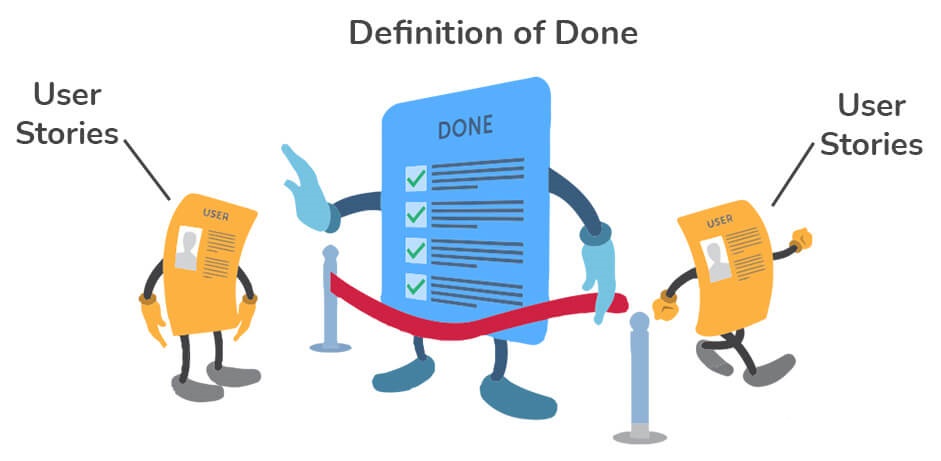
It assists with:
- Identifying the steps necessary to complete the iteration.
- The use of appropriate technologies, such as burndown, to improve the efficiency of the process.
- Providing timely input at all stages of the project’s life cycle.
- Assuring that the product backlog items are properly walked through and understood.
- The establishment of a checklist for the backlog items in the product.
- Assuring that it is defined in such a way that it is task-oriented.
- Including the product owner in the sprint review and sprint retrospective.
What is the purpose of a Scrum Master to be present at the Daily Scrum?
A Scrum Master is not required to be present; all that is required of him or her is that the Development Team has a Daily Scrum. Only Development Team members are allowed to participate in the Daily Scrum. Although the Scrum Master or Product Owner is welcome to attend this meeting to help with the Daily Scrum, Scrum does not necessitate it. During the Daily Scrum, the Development Team members synchronize their work, track their progress toward the Sprint Goal, and, if necessary, adjust the Sprint Backlog and the plan for the following 24 hours.
What do you mean by ‘Confidence Vote’ in Scrum? Why is it important?
After the risk analysis, the Confidence Vote is conducted at the Program Increment Planning session. It is when all members of the team meet together and raise their voices and vote with their fingers on their confidence level in the completion of the PI Targets. Only when all of the features and user stories have been appropriately estimated and prioritized can the confidence vote be used. All of the work that is being done must be transparent to all parties involved, with all dependencies and hazards clearly defined.
With a vote of confidence, you can create an environment where individuals feel free to share and express their opinions. It boosts team members’ morale since they should feel that their opinions are respected.
What do you mean by Scrum of Scrums?
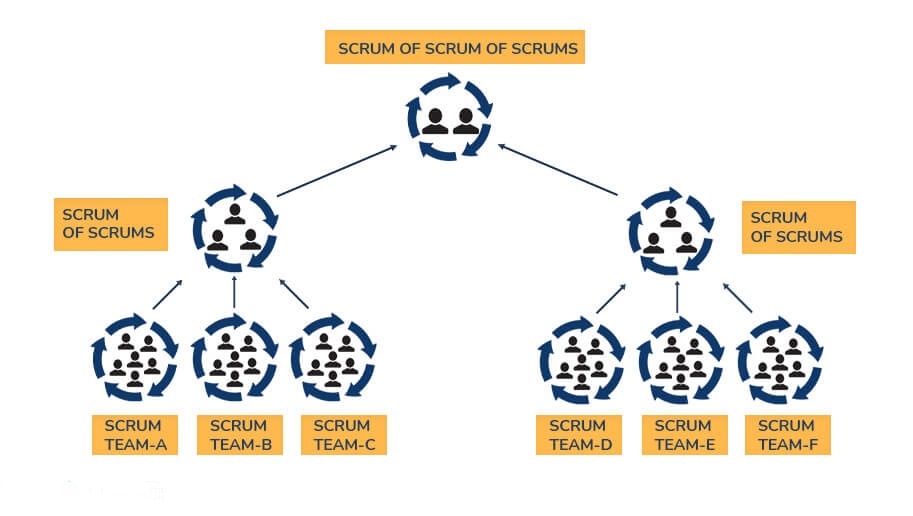
Scrum of Scrums is a scalable agile technique for connecting several teams that must collaborate to produce complicated solutions.
It enables teams to design and deliver complicated products at scale by facilitating transparency, inspection, and adaption. It’s especially effective when all members of a high-performing Scrum team work toward a single purpose, have complete trust and respect for one another and are completely aligned. It is a virtual team made up of delegates who are connected to the original delivery teams via embedded linkages. These interconnected team architectures simplify communication paths when compared to traditional organizational hierarchies or project-based teams. The goal is to coordinate smaller, self-contained groups.
Differentiate between MVP and MMR.
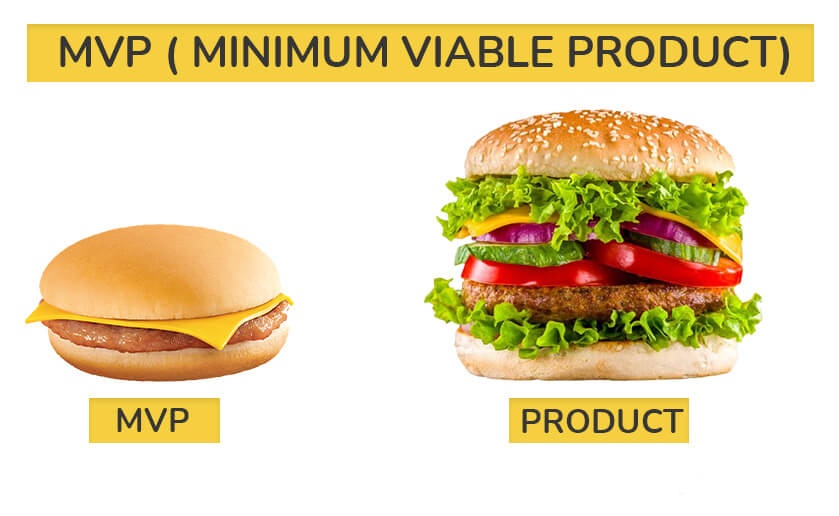
Minimum Viable Product (MVP) is a Lean Startup concept that emphasizes the importance of learning while developing a product. This enables one to test and understand the concept by exposing target consumers and users to the initial version. To accomplish this, one must first gather all pertinent data and then learn from it. The MVP concept is to create a product, provide consumers access to it, and observe how the product is used, perceived, and understood. This will also give you a better idea of what the needs of your clients or users are.
Successful products are released into the market in stages over time, with each “significant” deployment referred to as a release. An MMR (Minimum Marketable Release) is a product release with the minimal possible feature set that solves your customers’ current new needs. MMRs are used to shorten time-to-market between releases by condensing each release’s coherent feature set to the lowest increment that provides new value to customers.
What are the three C’s in an User Story?
Following are the three C’s in a User Story:
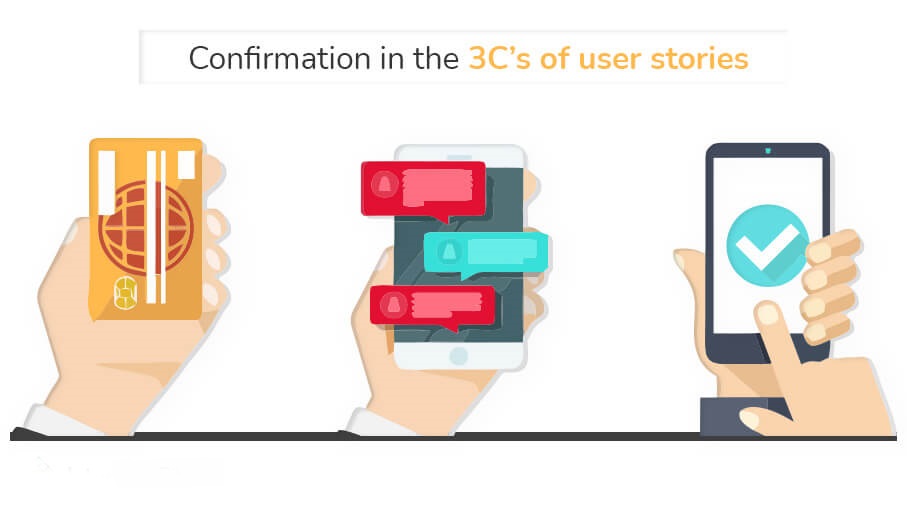
- Card: It is a written account of the story that is utilized to plan and estimate. To keep user stories succinct, they are manually written on index “cards.”
- Conversation: The Conversation is required to learn more about the Card. The conversation encourages the agile team to work together in small steps to develop a shared understanding of the problem and potential solutions.
- Confirmation: Confirmation is an acceptance criteria that contains the fundamental requirements and turns them into test criteria so that we can determine when the user story has been properly provided.
How will a Scrum Master prevent extreme weariness induced due to retrospectives?
When Scrum teams repeat the same pattern of a retrospective sprint after sprint, the teams become tired of it. The Scrum Master must be willing to experiment with different patterns and, on occasion, change the location. Anything that occurs on a regular basis in the same format tends to generate a dull meeting setting. Some teams may choose to go out to lunch and have a conversation there; this not only facilitates collaboration but also creates a safe setting in which to speak. The Scrum Master must ensure that the substance of a retrospective is not lost while creating a favorable environment to prevent boredom. Even if you’re employing various patterns, the intent should remain the same.
The Agile methodology emphasises the importance of "People Over Processes." Is the Scrum Master's responsibility of enforcing "the process" a contradiction?
Despite the fact that Scrum describes the Scrum Master as the person in charge of enforcing the process, it is critical to understand what this enforcing position entails and what its limitations are.
Enforcement does not imply forcing the team to follow the process; rather, it entails putting Scrum’s essential elements into practice to aid the teams’ success. The Scrum Master is a facilitator who assists the teams in achieving their objectives. The Scrum Master will apply Scrum methods and urge the team to follow the scrum values during facilitation.
It is critical to emphasize that we are discussing encouragement rather than coercion. It is not a project manager’s role, but it will assist teams in resolving their roadblocks; it will be a collaborative effort rather than a directive one. The scrum master will try to demonstrate the benefits of adopting the processes and assist the team in gaining a grasp of the scrum processes from time to time, which is similar to demonstrating the proper route but allowing the team to choose whether or not to go down it. The scrum master will also serve as a mentor for the team, assisting them in achieving success in their agile journey.
How will the Scrum Master make sure that the team delivers action items on time?
The team must identify action items in order for the retrospective to be effective. This provides the team with a starting point for a discussion, but simply naming will not suffice. The action items should be closed as soon as possible, and the scrum master should take steps to accomplish this. Every action item should have an owner, and teams should avoid assigning several owners to a single item because ownership becomes diluted. The scrum master should keep track of action items in a programme or spreadsheet that is accessible to everyone on the team. Having a backlog of action items is also beneficial since it allows the team to prioritize.
What do you mean by Velocity in the context of Scrum? Does having maximum Velocity ensure maximum Productivity?
The amount of work performed by a team during a sprint is measured by velocity. It refers to the number of user stories that have been finished in a sprint.
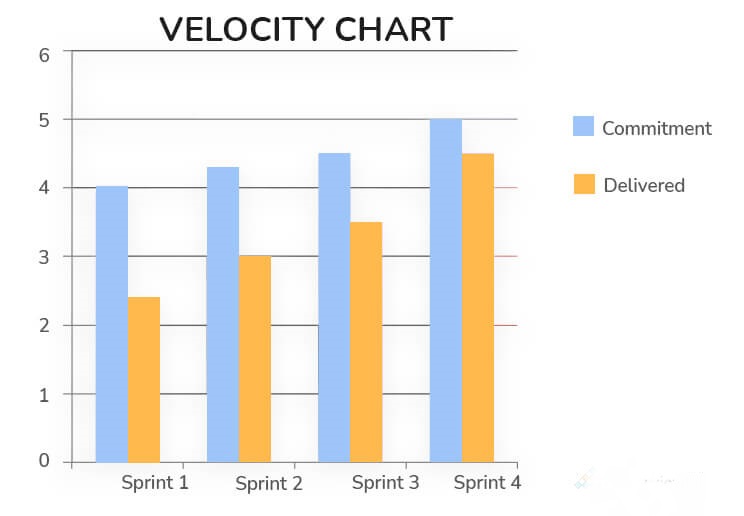
No, having maximum Velocity does not ensure maximum Productivity. A team’s attempt to enhance velocity may actually result in the reverse. If pressed for time, a team may forgo unit or acceptance testing, reduce customer collaboration, forgo issue fixes, minimize refactoring, and many other critical benefits of the agile development approach. While there may be a short-term benefit, there will be a long-term detrimental consequence. The goal is to achieve optimal velocity over time, which takes into account a variety of parameters, including the end product’s quality.
How can a Scrum Master ensure that the three pillars of Scrum are being implemented by the team?
Following are the ways by which a Scrum Master can ensure that the three pillars of Scrum are being implemented by the team:
- Daily Scrum:
Examine the Team Board and adjust the plan for the next day, making sure that any changes are communicated to the entire team.
Examine the Impediments Board and, if necessary, adapt ways to address impediments. - Sprint Planning:
Examine the average Team Velocity for the preceding three or four Sprints, verify that the velocities were transparent to the team, and verify that the team adapted the Velocity to be used for Sprint planning.
Examine the Product Backlog (PB) to ensure that it is current, transparent to all stakeholders and that the team adjusts the PBI estimations as needed. - Sprint Retrospective:
Examine the procedure that was followed and make preparations to adapt it if required, ensuring that any modifications are communicated to all team members. - Sprint Review:
Inspect the increment and, if necessary, adjust the Product Backlog, ensuring that any changes are communicated to all stakeholders.
Examine the Release Plan and make any required adjustments, ensuring that any changes are communicated to all stakeholders.
What do you mean by Scrum Master as a Servant Leader?
A servant-leader is someone who :
- Focuses on establishing a trusting relationship.
- Encourages transparency and empowerment.
- Encourages teamwork and collaboration
- Demonstrates ethical and compassionate behavior by prioritizing the needs of others.
- Is humble, well-informed, upbeat, socially conscious, and situationally aware.
A Scrum Master is a master at motivating, enabling, and inspiring individuals to work together as a team and reach their maximum potential. A Scrum Master is a servant-leader who prioritizes the needs of team members and those they serve (customers), with the purpose of generating results that are consistent with the organization’s values, principles, and goals.
The Scrum Master’s responsibilities as a servant-leader include:
- Setting Scrum up as a servant rather than a commanding process.
- Assisting the Development team in becoming self-organized.
- Guiding the group via constructive conflict and debate.
- Scrum adoption and use are taught, coached, and mentored by the organization and team.
Is daily standup recommended for all teams regardless of their size and experience level. Explain.
The daily stand-up meeting allows the team to reflect on how the team’s commitment to the sprint goal is progressing. As a result, all agile teams should meet on a frequent basis to ensure that everyone is on the same page. Depending on the size and level of experience, the standup can be done in a variety of ways.
- Small and Experienced – If the team is small and the members are experienced, they can meet for a quick break or even an informal meeting.
- Small and Inexperienced – If the team is small and inexperienced, the Scrum Master should prefer going through a formal standup because the team needs to understand the progress, they may require assistance with technicalities or business functionality, and they must also understand the values, principles, and discipline in the process.
- Large – With large teams, taking a casual approach may be problematic, as formal meetings are essential to provide guidance and clarity.
- Distributed Teams – Because there is a location constraint in the case of scattered teams, the teams can use the ‘dial-in’ and conduct the daily scrum in an organized manner.
What do you understand about Scope Creep? How can Scope Creep be managed?
Scope creep describes how a project’s requirements tend to grow over time, such as when a single deliverable product gets split into five or when a product with three essential features needs ten essential features or when the customer’s needs change midway through a project, prompting a reassessment of the project requirements. Scope creep is frequently caused by changes in project requirements from key stakeholders, as well as internal miscommunication and conflicts.
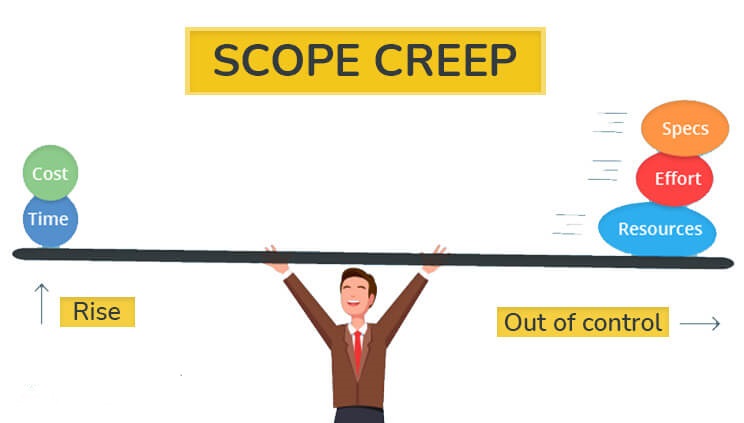
Controlling scope creep through a change control procedure is the key to managing scope creep. This entails:
- Keeping track of the project’s progress and establishing a baseline scope
- Using variance analysis to compare actual work performance metrics to the baseline scope, i.e., “How different is the present project from the initial plan?”
- Identifying the source and severity of the observed changes
- Choosing whether corrective or preventive action is required in response to change requests
- Using the Perform Integrated Change Control procedure, manage all change requests and recommended actions (whether corrective or preventive)
Can the Scrum team be involved in the product discovery process? If so, explain how.
Making the scrum team a participant in the discovery process early in the product development lifecycle is quite beneficial. Agile refers to teams engaging with stakeholders early in the development process so that both parties are on the same page. Consider some of the benefits of early involvement:
- The development teams can help in modifying the specifications with the client by identifying technical implementation issues early in the process.
- Along with the product owner, the team begins to share a shared knowledge of what needs to be built. Teams can sometimes assist the product owner in detecting requirements that might have been overlooked.
- They have a common concept of what needs to be constructed. It also helps teams stay dedicated and confident, encourages them to take ownership of their job, and, most importantly, increases team spirit.
- To help with this, the scrum master can begin including the teams in early product discussions when the requirements are still vague. The product backlog can be built by the team and the product owner.
When should a Scrum Master not act as a facilitator?
Although a Scrum Master is supposed to help the team get the best results, workshop facilitation can be tricky at times. A workshop facilitator must be impartial to the topics being addressed and should refrain from adding facts or opinions to the discussion. If the Scrum Master has the necessary expertise, he or she can facilitate most general product development workshops. However, if the workshop is about changing the Scrum process, the Scrum Master should not facilitate that session.




